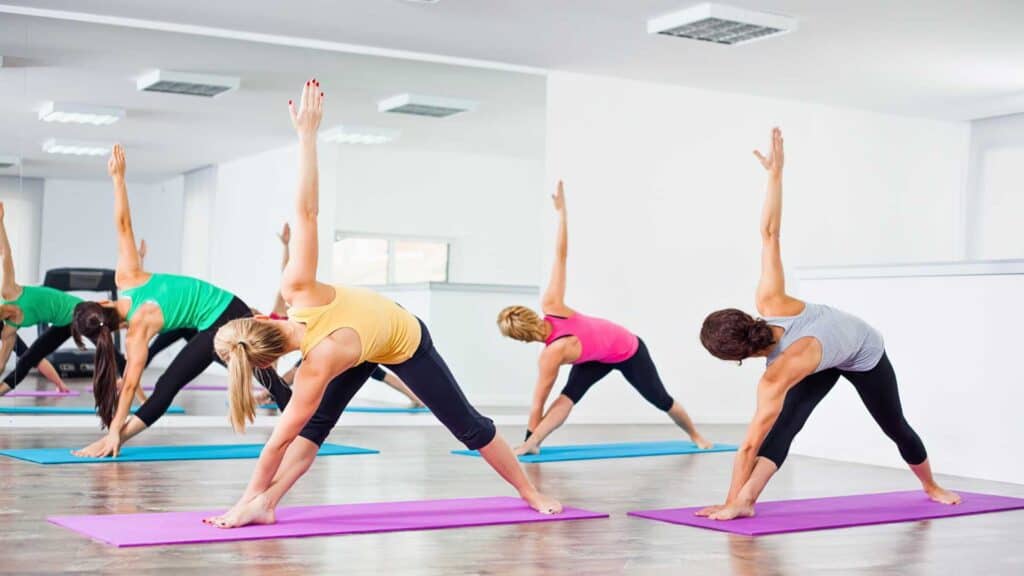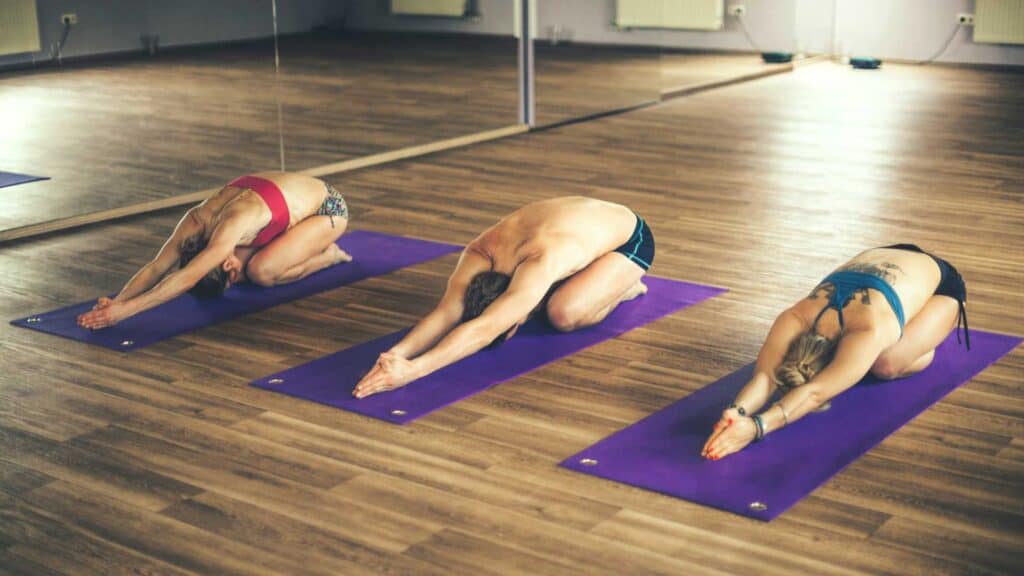Hot yoga and Bikram yoga both take place in a heated environment, which is a draw for those looking to increase their flexibility and sweating during their practice. However, despite the similarity in their sweaty settings, there are key distinctions to be aware of.
Bikram yoga is a precise sequence of 26 poses and two breathing exercises. This form is always performed in a 90-minute class in a room heated to 105°F with 40% humidity.

In contrast, hot yoga refers to any yoga practice done in a heated room and can include a variety of poses and sequences, depending on the instructor’s design. The temperature in hot yoga classes can vary and does not adhere to the strict Bikram guidelines.
Offering more flexibility in its practice, hot yoga allows instructors to create sequences that might be more accessible or varied for their students.
With both practices offering health benefits like improved flexibility and stress reduction, choosing the right one for you might come down to personal preference and your desired yoga experience.
We explore Hot Yoga vs Bikram Yoga to help you choose.
Key Takeaways
- Bikram yoga features a specific sequence of 26 postures in a heated room.
- Hot yoga includes variable sequences and temperatures.
- Choosing between Bikram and hot yoga depends on your preference for structure or variety.
Defining Hot Yoga and Bikram Yoga

You’ll find that not all hot yoga is created equal when exploring the world of heated yoga classes. Here, we’ll focus specifically on defining Hot and Bikram Yoga, including their distinct characteristics.
What is Hot Yoga?
Hot yoga refers to any yoga class that takes place in a heated room, with temperatures typically ranging from 95 to 105 degrees Fahrenheit. The heat makes your muscles more pliable, enabling a deeper stretch while promoting detoxification through sweating.
The structure of a hot yoga class can vary widely depending on the instructor or studio, meaning sequences and postures differ from one class to another.
The freedom to incorporate various yoga styles makes hot yoga diverse and accommodating to many preferences.
Benefits of Hot Yoga
Hot Yoga, a broader term for practicing yoga in warm conditions, increases flexibility and encourages detoxification. The heat supports cardiovascular health and builds strength. Mentally, it sharpens focus and aids in stress management, improving overall well-being.
What is Bikram Yoga?
On the other hand, Bikram is a specific type of hot yoga that Bikram Choudhury developed. This practice involves a series of 26 postures and 2 breathing exercises in a room heated to 105 degrees Fahrenheit with 40% humidity.
Bikram Yoga classes are 90 minutes long and follow the same sequence every time, ensuring consistency across classes and studios.
Unlike hot yoga, Bikram has strict rules—music, clapping, and hands-on instruction are not typical features of a Bikram class.
Benefits of Bikram Yoga
Bikram Yoga, performed in a room heated to 105 degrees, significantly enhances flexibility and aids in detoxification through intense sweating. Its 26 poses strengthen muscles and improve balance, while the discipline required for practice promotes mental clarity and stress relief.
Key Difference Between Bikram and Hot Yoga

Exploring hot yoga and Bikram yoga reveals differences in postures, class structure, and studio environment.
Posture and Flow Comparisons
In Bikram yoga, you’ll engage in a specific set of 26 postures and two breathing exercises. These are conducted in the same sequence every class, offering consistency and the ability to monitor your progress.
In contrast, hot yoga may involve a variety of postures depending on the instructor, including Vinyasa-style sequences, which are more fluid and can change from class to class.
Class Structure and Duration
Your Bikram yoga session will always last 90 minutes, ensuring ample time to work through the classic sequence.
Hot yoga class lengths can vary, providing more flexibility to fit within your schedule.
Both styles are taught in heated rooms, but Bikram insists on a strict 105 degrees Fahrenheit with 40 percent humidity to emulate the climate of India.
Atmosphere and Studio Settings
When you step into a Bikram studio, expect a carpeted floor with mirrors along the front wall to help you maintain proper form.
Hot yoga studios might offer different types of flooring and less rigorous atmosphere norms.
The use of mirrors and the exact room setup in a hot yoga class often depends on the individual studio’s philosophy and layout.
Health Benefits and Considerations

In exploring the distinctions between hot yoga and Bikram yoga, it’s essential to understand their respective health benefits and key safety measures to ensure an optimal and secure practice.
Physical and Mental Advantages
Hot yoga offers a variety of benefits, improving flexibility and balance due to the warm environment, which helps your muscles relax.
Regular practice may also enhance lung capacity as you adjust to breathing in a heated setting.
On the mental wellness front, yoga’s meditative aspects can reduce stress and foster a sense of well-being.
Bikram yoga, a specific form of hot yoga, consists of 26 postures and two breathing exercises in a room heated to approximately 105°F with 40% humidity.
This structured environment is designed to systematically work every part of your body, with potential benefits including the detoxification of the body and potential improvements in cardiovascular functioning.
The heat can be soothing for those with rheumatoid arthritis; one study found that hot yoga reduced pain and improved mood among participants.
Factors to Consider Before Practicing Bikram or Hot Yoga
It’s important to talk with your doctor, especially if you have pre-existing health conditions that heat and intense exercise can affect you.
Knowing your health status can help you choose whether hot yoga or Bikram yoga suits you.
Hydration is a key consideration; drink plenty of water before, during, and after to prevent dehydration due to sweating.
Monitor your body’s responses throughout practice; if you feel dizzy, light-headed, or overly fatigued, allow yourself to rest or leave the room.
Hot yoga isn’t recommended during pregnancy due to the risks of overheating.
Always ensure that your instructor is certified and experienced in teaching hot or Bikram yoga to guarantee a safe practice environment.
Choosing Your Practice

Deciding between hot yoga and Bikram yoga is a personal choice that can influence your overall yoga experience. Both practices involve a heated environment but have distinct differences that could sway your preference.
Where to Start
When beginning your journey, assessing what you’re looking for in a yoga practice is important.
Hot yoga offers a variety of styles and sequences that change from class to class, providing a diverse experience in a room heated between 80 and 105 degrees Fahrenheit.
In contrast, Bikram yoga is more structured, featuring a set series of 26 postures and 2 breathing exercises in a room heated to 105 degrees Fahrenheit with 40% humidity.
Your decision may hinge on whether you prefer the consistency of Bikram or the variability of hot yoga classes.
Finding the Right Studio
Selecting a yoga studio is critical in establishing a routine that suits your lifestyle and comfort level.
- Hot Yoga Studio: Look for studios that specify the type of hot yoga they offer, as it can range from Vinyasa to other dynamic styles. Check the class schedule to see the room’s variety and temperature set. Speak to the yoga instructor to find out this information. Check out the best mats for hot yoga.
- Bikram Studio: These studios will explicitly state they offer Bikram yoga. Ensure they adhere to the traditional Bikram environment—105 degrees with 40% humidity and a 90-minute class comprising the specific Bikram series. Speak to the yoga instructor to find out this information.
Origins and Creators

Exploring the roots of Hot and Bikram yoga, you’ll uncover a journey of evolution and personal branding. From its origins to the pivotal role played by a certain individual, your understanding of these practices is about to deepen.
Development of Hot Yoga
Hot yoga is a broad term for any yoga practice conducted in a room that has been heated, typically to between 95 and 105 degrees Fahrenheit.
This heat is meant to increase muscle flexibility and induce sweating, which proponents believe aids detoxification. The practice draws from traditional yoga techniques and, over time, has diverged into various styles under the hot yoga umbrella.
Interesting Fact: Exercising in a heated environment has ancient roots but has been widely popularized in recent decades.
Bikram Choudhury and His Practice
Bikram Choudhury is the founder of Bikram Yoga. He started this form of hot yoga in the early 1970s. His method consists of 26 yoga postures and 2 breathing exercises. These are performed in a 90-minute session in a room set at the same high temperatures typical of hot yoga. While often referred to as “Original Hot Yoga,” and the term “Bikram Yoga” became synonymous with the specific sequence of poses and conditions under which it is practiced.
Bikram’s Impact: Choudhury’s contribution to the hot yoga movement cannot be overstated. His structured sequence set a precedent for others to follow and modify, leading to the broad landscape of hot yoga available today.
